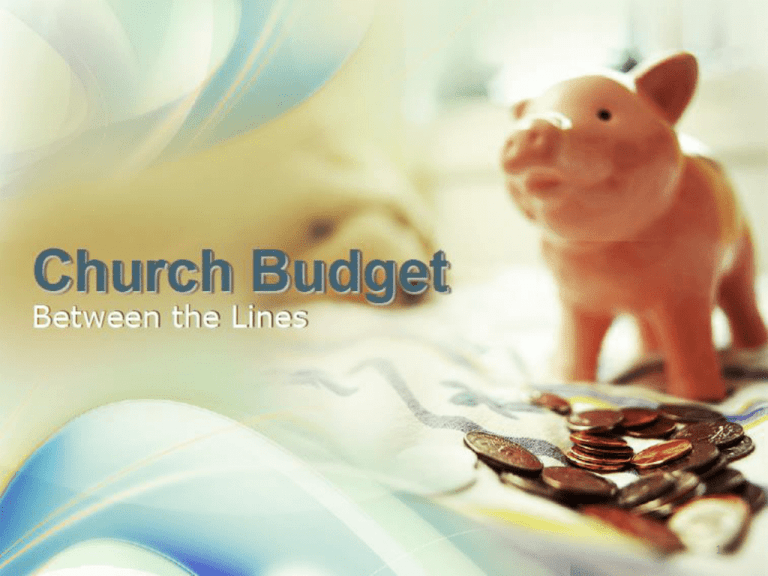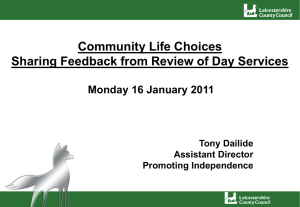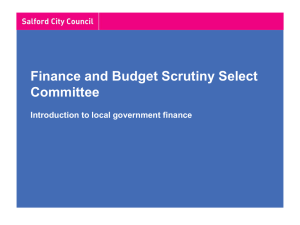Church Budget Between the Lines
advertisement

1 •“But let all things be done properly and in an orderly manner.” (1 Cor. 14.40 NASB) 2 Introduction Ask different people about budgets and you will get different answers. To staff members, budgets get in the way of activities. To the budget-review committees, budgets hold staff members accountable. To those compiling and coordinating the budgets of varying ministries, it consumes vast amounts of time and may have questionable benefits. However, budgets are critical to any church's future success. • Budgets show the allocation of resources • They are used to authorize action • Budgets also provide boundaries and benchmarks • Budgets are tools that help financial leaders 3 What budgets cannot do • Budgets do not motivate the majority of people to give. • Budgets rarely communicate. A surprisingly small percentage of the American population can read and understand budgets, especially line-item budgets. Too many churches distribute copies of the annual budget, believing that they have communicated important information. Upon closer examination, it becomes clear that very little communication has occurred. • Budgets miss the reason why people give. People do not give to budgets. They give less from the head than from the heart. People give to other people, to needs, to causes — to things that make them feel good and happy. 4 A budget should reflect the mission • If you want to know the passion of someone, it's real simple, just look at where they spend their money. If you have spent any time in ministry you have noticed if not studied the spending habits of your congregation. The old statement that says, "if you want to know where my heart is, look at my checkbook" is the clearest indication of my personal mission. • The same is true with an organization, especially nonprofits and even more true of churches. • As your mission statement should clearly define what is important to your ministry, your budget should be a reflection of your statement and define how you plan to financially support that mission. 5 A budget should reflect the mission (cont.) • You must understand the actual values of a congregation before you can effectively influence the budget process. And often the budget is the best indication of what the leadership values. • At a glance the budget seems to confirm that a church boasts that it is a strong mission’s congregation, but a closer look reveals that most items in the mission section of the budget are not really “mission support.” It turns out that anything leadership wanted but thought might be difficult to sell to the church was labeled missions. (So the mission section of the budget was bulging with children’s and preschool ministry activities.) 6 7 What is more important? • Balanced Budget or Positive Cash Flow? Many people do not understand that although something is budgeted, that there may not be cash flow to make the expenditure. • It’s the same as having checks, but no money in the bank. Cash Flow is Important, and a well thought out budget can make that happen. 8 Budget Categories and Types • Income – – – – – Tithe/Offering Investment Earnings Rental Leases Program / Seminars • Etc. (What are other sources of income you can get from your facilities?) • Expense – – – – – – Salaries Property/Facilities Programs Worship Missions (Can be budgeted separately and not included with operations) Numerous (etc.) 9 10 Budget Types Which kind should I use? 11 Zero Based Budget Defined • The zero-based budget is similar to what's used by the executive branch of the U.S. government. The government annually reduces all budgets to zero, making it necessary for every department to justify all financial needs for the coming year. • The zero-based budget forces a church to evaluate needs every year. 12 Zero based Budget (cont.) • Most churches use a "zero-based" budgeting process. That is they start each year at zero and develop a new budget based on planned ministries of the church for that year. • There is not carry over of income or expense from the previous year on any specific line item. this process may be adjusted somewhat hereby the new budget would be developed based on – fixed costs – other additions or variables 13 14 Zero-based (cont.) • The time involved in justifying a zero-based budget can be burdensome. Yet with line-item budgets, programs and expenditures that should be modified or eliminated are often carried forward without change. Furthermore, a proportional reduction of budget funding can affect a critical ministry program, rendering it virtually useless as less- important ministry programs move forward. 15 Line Item Budget Defined The line-item budget is what the legislative branch of the U.S. government uses. It retains line-item expenditures from year to year, making modifications as needs increase or decrease line-item budget eliminates the need for detailed analysis. 16 17 Program Budget Defined • Costs are identified with the specific programs being carried out by the church. • Program budgeting operates on the premise that programs operate to achieve certain purposes, and by clearly establishing these purposes the church can improve both the use of its resources and the effectiveness of programs. This approach forces the church to do planning before preparing the budget. • Program budgeting has several advantages. It provides a better understanding of what each program is attempting to do and directs program leaders to pay attention to program achievement. It also offers a clearer picture of what church members' contributions are supporting. On the negative side, program budgeting takes considerably longer than incremental budgeting. Program budgeting cannot be done properly without planning. 18 Program Budget (cont.) These are the Steps in Program Budgeting: • 1. Define Program Objectives in terms of output • 2. Delineate activities needed to carry out objectives • 3. Determine the nature and levels of resources needed to support the activities • 4. Determine the budget requirements to provide resources listed in step 3 • 5. Prepare a performance budget for each activity • 6. Prepare a program budget by grouping performance budgets by objectives. 19 20 Program Budget Categories • A program budget actually operates mini budgets by dividing expenditures into a certain categories. • Operations • Missions • Salaries • Evangelism • Education • Worship • Facilities • Youth 21 Narrative Budget Defined The narrative budget is one way to give people — especially those in leadership positions — an opportunity to experience the mission and ministry that are achieved through the various line items. It focuses less on the financial numbers and more on what the income accomplishes. It is a one- to two-page presentation that explains: (1) what the church hopes to accomplish and (2) why the funding is needed to reach and exceed its goals. 22 Narrative Budget Defined (cont.) • Shows what ministries are to be supported and describes the church's ministries in terms of activities and results made possible by contributions of time, talent, and treasure. • The focus is on the ministries, not the numbers. • It shows how leadership is budgeting resources to carry out the congregation's mission and helps demonstrate its accountability to the rest of the membership. All expenses, including the so-called "fixed" expenses of utilities and salaries are divided up and seen as parts of "real" areas of ministry of the church. • A further virtue is that it reminds the congregation that church leaders are managers of ministry resources. This type of budget is used more for communication that financial reporting. 23 24 25 26 27 Has anyone thought about Objectives of the budget? • Bad objective: Have more people in Sunday School next year. • Good objective: Increase our average Sunday School attendance by 10 percent over last year. • Bad objective: Expand Sunday School. • Good objective: Start three new Sunday School classes in the next year, one in January and two in September 28 Budgeting is strategic planning and assessment. (Questions must be asked) • What are the distinctions of our church? Or, to put it another way: If the church were to cease operation tomorrow, what difference would it make? • If the church's budget were cut by 50 percent, what are the things you would keep? • What did we do right this year? • What ministry area should we expand, enhance or begin next year? • What did we do wrong this year? • What should we discontinue? • Are there any activities whose time is past and should no longer be funded? • Is this activity or event consistent with our goals? • Do we have sufficient staff to implement our plan? • Who should be involved in the planning process? 29 30 Income and Expenses • Everyone wants to know what they should spend and where. • It is hard to quantify certain numbers because of subjectivity. – Location Influences – Size of Congregation Influences – Age of Congregation Influences – Education Influences 31 Telling you a number is impossible • Budgets are works in progress. – The data must be examined • Things you should examine –Percentage of tithers –What is the per capita giving in your church –What are the highest giving months –What are the lowest giving months –What is the average income in your city –What is the growth rate in your city 32 33 Average American Church Budget Average Amount STAFF COMPENSATION FACILITIES 118,601 64,617 Debt Retirement or Rent 27,491 Utilities 13,900 Maintenance / Cleaning 12,215 Property/Liability Insurance 4,675 Other 6,336 MISSIONS 33,259 World Missions US Missions 25,876 7,383 CHURCH PROGRAMS (Education, Youth, Music, etc.) 24,675 ADMINISTRATION AND SUPPLIES 17,853 NATIONAL OFFICE CONTRIBUTSIONS/FEES OTHER (INCLUDES RESERVES) 1,539 12,430 34 35 Margin • One of the largest mistakes in budgeting is simply looking back 3 or 4 years and collecting the data that shows each year the church budget has increased by 4 or 5 or maybe 15% and average those figures out to determine what percentage of growth to expect the next year. • This isn't the mistake, the data is relevant. The way in which the data is then applied is often where the mistake come in. • Upon finding the average percentage of growth, we then apply that same percentage to the overall income and expense budget. • No where in this process is there any determination of the growth allocated to "Margin.“ • Developing Margin into your budget is a wise choice that essentially determines that you do not plan to spend all of your income. 36 Margin • Many budgets do include a line called "Contingency;" however that is not the same as margin. "Contingency" would be budgeted to reach a desired goal. A contingency fund should be the equivalent of two to three months of operating expenses. • Margin is net income at the end of the year in excess of the budgeted amount. 37 Margin • So what is a ministry to do when they have money left in the budget at the end of the year. Let me suggest an idea which blends a zero-based budget aspect to this scenario. When a church has an excess at year end, do not carry that over to next years budget, keep it available by doing one of the following: – 1. Investing it in a short term money market where you can maintain some liquidity for cash flow, this could be very helpful in the summer months when giving declines but usually expenses climb. – 2. Invest in a long term strategy for capital improvements, and strategic planning for future staff. This can also prove helpful in the purchase of large ticket items in the future. – 3. Apply the excess to debt retirement. 38 39 Good rules of thumb? • It is advisable that a church look at the following percentages as a rule of thumb in budgeting local receipts and make adjustments to based on their objectives. Missions 10% Personnel expenses (salaries and housing allowance) 40% Education, outreach, local ministries expenses 20% Building (rental, purchase, utilities, insurance, etc.) 30% 40 Rule of Thumb • Other analyst say: – Personnel and Debt Service should not exceed 60% of total budget. (Those are long-term fixed expenses and therefore only leaves 40% to focus on advancing the growth of the church.) When asked "What would you do with an unexpected financial windfall?" 31 percent of pastors said they would build, expand or update their church buildings and facilities. 7 percent said they would give more to foreign missions and evangelism. – Debt Service should not exceed 36% of total budget. – Personnel should range between 35% and 55% 41 It’s difficult to say what your budget should be, but… • The lower your administrative costs, the more money you could put to other ministries. • One church report I recently looked at with a 1 million dollar budget showed the amount of salvations. The number was “1” • I would never try to quantify the value of a soul, but a million dollar budget should see more souls transformed! This is obviously a church very internalized. 42





